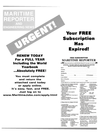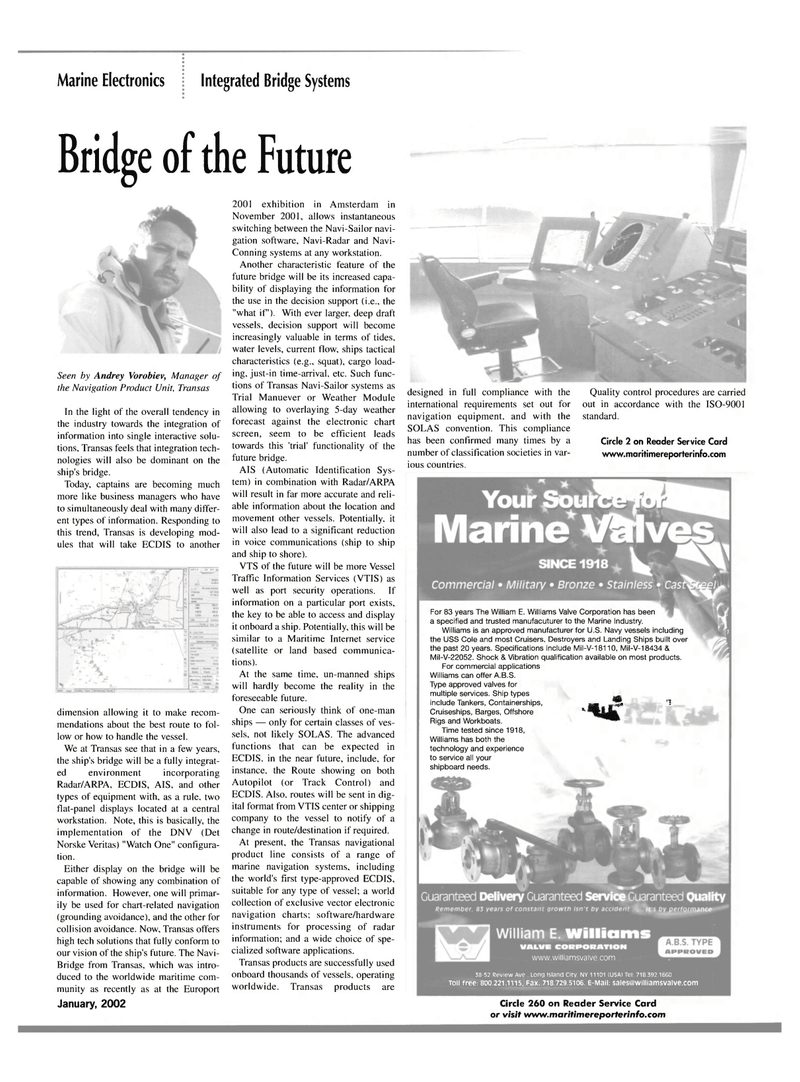
Page 44: of Maritime Reporter Magazine (January 2002)
Read this page in Pdf, Flash or Html5 edition of January 2002 Maritime Reporter Magazine
Marine Electronics i Integrated Bridge Systems
Bridge of the Future
Seen by Audrey Vorobiev, Manager of the Navigation Product Unit, Transas
In the light of the overall tendency in the industry towards the integration of information into single interactive solu- tions, Transas feels that integration tech- nologies will also be dominant on the ship's bridge.
Today, captains are becoming much more like business managers who have to simultaneously deal with many differ- ent types of information. Responding to this trend, Transas is developing mod- ules that will take ECDIS to another dimension allowing it to make recom- mendations about the best route to fol- low or how to handle the vessel.
We at Transas see that in a few years, the ship's bridge will be a fully integrat- ed environment incorporating
Radar/ARPA, ECDIS, AIS, and other types of equipment with, as a rule, two flat-panel displays located at a central workstation. Note, this is basically, the implementation of the DNV (Det
Norske Veritas) "Watch One" configura- tion.
Either display on the bridge will be capable of showing any combination of information. However, one will primar- ily be used for chart-related navigation (grounding avoidance), and the other for collision avoidance. Now, Transas offers high tech solutions that fully conform to our vision of the ship's future. The Navi-
Bridge from Transas, which was intro- duced to the worldwide maritime com- munity as recently as at the Europort
January, 2002 2001 exhibition in Amsterdam in
November 2001, allows instantaneous switching between the Navi-Sailor navi- gation software, Navi-Radar and Navi-
Conning systems at any workstation.
Another characteristic feature of the future bridge will be its increased capa- bility of displaying the information for the use in the decision support (i.e., the "what if"). With ever larger, deep draft vessels, decision support will become increasingly valuable in terms of tides, water levels, current flow, ships tactical characteristics (e.g., squat), cargo load- ing, just-in time-arrival, etc. Such func- tions of Transas Navi-Sailor systems as
Trial Manuever or Weather Module allowing to overlaying 5-day weather forecast against the electronic chart screen, seem to be efficient leads towards this 'trial' functionality of the future bridge.
AIS (Automatic Identification Sys- tem) in combination with Radar/ARPA will result in far more accurate and reli- able information about the location and movement other vessels. Potentially, it will also lead to a significant reduction in voice communications (ship to ship and ship to shore).
VTS of the future will be more Vessel
Traffic Information Services (VTIS) as well as port security operations. If information on a particular port exists, the key to be able to access and display it onboard a ship. Potentially, this will be similar to a Maritime Internet service (satellite or land based communica- tions).
At the same time, un-manned ships will hardly become the reality in the foreseeable future.
One can seriously think of one-man ships — only for certain classes of ves- sels, not likely SOLAS. The advanced functions that can be expected in
ECDIS, in the near future, include, for instance, the Route showing on both
Autopilot (or Track Control) and
ECDIS. Also, routes will be sent in dig- ital format from VTIS center or shipping company to the vessel to notify of a change in route/destination if required.
At present, the Transas navigational product line consists of a range of marine navigation systems, including the world's first type-approved ECDIS, suitable for any type of vessel; a world collection of exclusive vector electronic navigation charts; software/hardware instruments for processing of radar information; and a wide choice of spe- cialized software applications.
Transas products are successfully used onboard thousands of vessels, operating worldwide. Transas products are designed in full compliance with the international requirements set out for navigation equipment, and with the
SOLAS convention. This compliance has been confirmed many times by a number of classification societies in var- ious countries.
Quality control procedures are carried out in accordance with the ISO-9001 standard.
Circle 2 on Reader Service Card www.maritimereporterinfo.com
For 83 years The William E. Williams Valve Corporation has been a specified and trusted manufacuturer to the Marine Industry.
Williams is an approved manufacturer for U.S. Navy vessels including the USS Cole and most Cruisers, Destroyers and Landing Ships built over the past 20 years. Specifications include Mil-V-18110, Mil-V-18434 &
Mil-V-22052. Shock & Vibration qualification available on most products.
For commercial applications
Williams can offer A.B.S.
Type approved valves for multiple services. Ship types include Tankers, Containerships,
Cruiseships, Barges, Offshore
Rigs and Workboats.
Time tested since 1918,
Williams has both the technology and experience to service all your shipboard needs. 1 -4.0? ^m t www.williamsvalve.com 38-52 Review Ave. Long island City NY 11101 (USA) Tel: 718.392.1660
Toll free: 800.221.1115, Fax: 718.729.5106. E-Mail: [email protected]
Circle 260 on Reader Service Card or visit www.maritimereporterinfo.com

 43
43

 45
45
